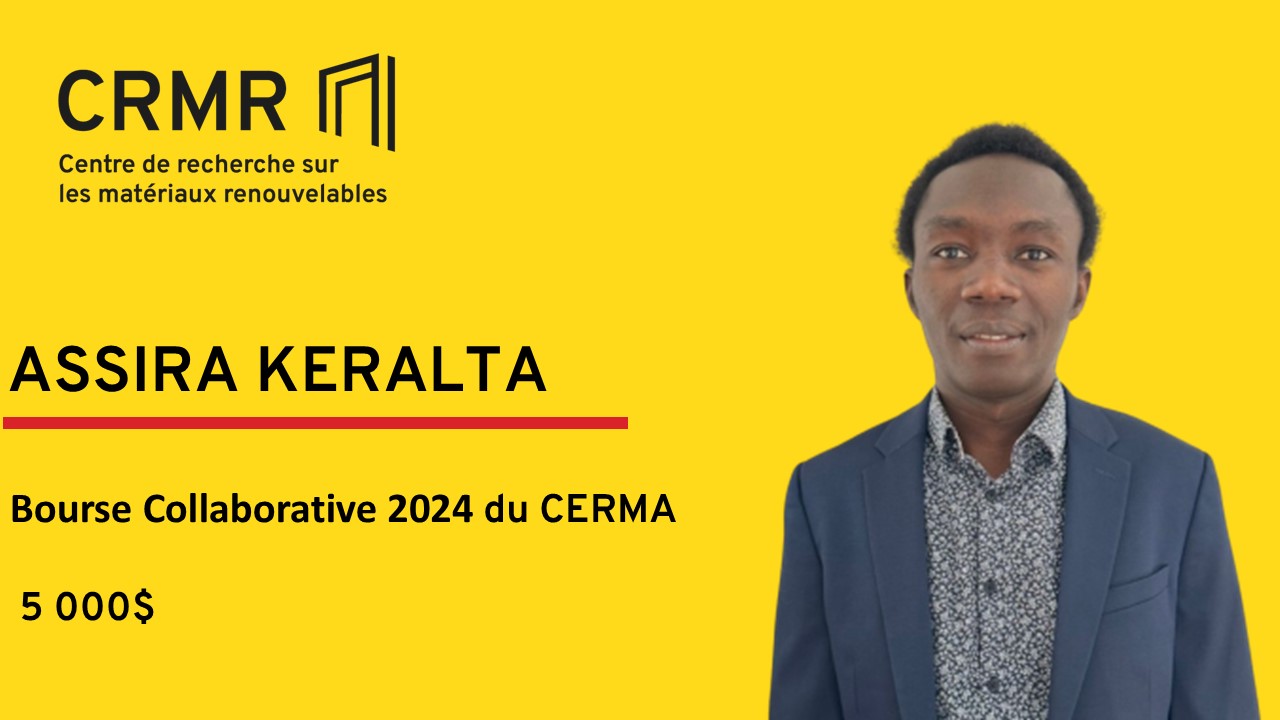Assira Keralta receives CERMA’s Collaborative 2024 grant worth $5,000!
Congratulations to Assira Keralta, recipient of the 2024 collaborative grant from the Advanced Materials Research Center (CERMA), worth $5,000. Assira is pursuing a PhD in wood and bio-based materials engineering under the supervision of Véronic Landry and co supervision of Julien Chamberland , in collaboration with Marie-Josée Dumont.
This scholarship aims to encourage the creation of new collaborative research projects involving multiple CERMA researchers. It also seeks to diversify the training of students, enhance their CVs, and promote the integration of sustainable development (SD) in projects, in alignment with CERMA’s strategic objectives. In 2024, this competition awards four scholarships of $5,000 each.
Congratulations to Assira on this great achievement!

Project title: Characterisation of reaction products between whey ultrafiltration permeate (WUP) and biobased acids and products formed during heating of WUP
Whey ultrafiltration permeate (WUP) is a liquid by-product generated during the purification of whey proteins. Essentially made up of lactose (80% on a dry mass basis), minerals (10% on a dry mass basis) and nitrogen compounds (5-10% on a dry mass basis), WUP cannot be discharged into the environment. It is considered a pollutant. However, its production has been steadily increasing in recent years.
In Quebec, WUP production is estimated at between 500 million and one billion litres a year. WUP can be dried by large companies and then used in food processing (e.g. bakeries, biscuit factories) and animal feed. However, these value-adding opportunities represent more of an economic loss than an income for processors, which is why it is so important to develop new ways of adding high value to WUP. It was with this in mind that this doctoral project on stabilisation in a circular economy context was developed. The project involves developing a new dimensional stabilisation technology for wood based on WUP. Thanks to its high content of lactose, a polyol, WUP impregnated with a biosourced carboxylic acid in the wood and heated will lead to an esterification reaction in situ in the wood. This leads to the formation of polyesters, which block the main moisture absorption sites in the wood. As a result, the hygroscopicity of the wood is reduced and the material gains in dimensional stability. In order to better understand the reaction between WUP and biobased acids leading to this beneficial result for the wood material, the esterification of WUP and biobased acids such as citric acid, fumaric acid, malic acid and succinic acid was carried out in the solid state. This reaction produces substances with different colours depending on the acids used.
This new technology for recovering WUP makes a good economic contribution compared with other existing recovery methods. This new technology consumes a large volume of WUP. What’s more, the WUP does not need any additional treatment such as drying, purification or separation before being used, whereas it is often these treatments that cause economic losses. The main objective of the project, in collaboration with the laboratory of Prof. Marie-Josée Dumont, is to characterise the products formed during these reactions. Initially, gas chromatography coupled with mass spectroscopy will be used to determine the structure of the main products resulting from the degradation of WUP as well as those resulting from its reaction with the various acids used.
Then, using combi-flash chromatography, we will accurately determine and quantify the products resulting from the thermodegradation of WUP, as well as the products and by-products formed during its reaction with acids. In addition, still using this chromatographic technique, a precise analysis of this reaction in situ in the wood will be carried out. Finally, the solution produced by washing samples of wood esterified with a mixture of WUP and biobased acid with water will be collected and analysed. These various analyses will lead to a better understanding of the reaction between WUP and biobased acids and its impact on the dimensional stabilisation of wood. These results will make it possible to explore new ways of using WUP in applications such as adhesives and coatings for wood products, hence the relevance of this project.

